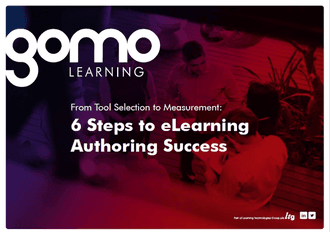9 questions that help define your eLearning authoring tool needs
In this extract from the first chapter of our latest ebook, From Tool Selection to Measurement: 6 Steps to eLearning Authoring Success, we look at the first of four key ideas to help you define your eLearning tool selection needs. Namely: defining your audience.
When you’re in the market for a new software tool, it can be difficult to define your needs and to prioritize accordingly. The eLearning authoring tool market is no exception: one L&D department’s essential feature may well be an unnecessary sideshow for another. We propose that there are four key ideas to help you define your needs: your audience, output, ecosystem, and partnership.
Defining your audience
You can only begin to understand your learning needs by understanding your audience. Ultimately, the goal of all L&D activity is to serve an organization’s employees with engaging learning content that results in more efficient and effective working practices as well as personal development. If your technology choices aren’t aligned to who your employees are and how they work, they’re poor technology choices.
Some of your audience’s requirements will be self-evident, while others require a little more digging to uncover. An organization with teams based in New York, London and Mumbai will understand that they require platforms that can account for needs in each location. You may have to explore existing usage data or use questionnaires to find out more about device usage or access habits.
Some questions you should be asking about your audience include:
- Where are your learners based? A platform that makes international hosting and/or distribution of courses easy will be needed if you have multiple offices in multiple countries.
- What languages do your learners speak? Both the nature of and the number of languages spoken by your audience have technical implications. You may need to accommodate right-to-left-reading languages such as Arabic. If you want to deliver the same training in multiple languages, a multilingual solution will save you significant time and effort.
- What devices do your learners typically use to access learning? The days of the desktop-only work habit are a distant memory. Mobile should at least be an option for most learners—and content should be designed to take advantage of its strengths and avoid its weaknesses.
- What are your learners’ typical working patterns? The importance of mobile and bandwidth-conscious versions of your content will increase if your learners are constantly on the road or working in remote areas.
- Do any of your learners have special access requirements? If any of your learners use assistive technology such as screen readers to access content, your tool choices will have to account for this (HTML5 compliance should have you covered). Having control over design aspects such as colors and interaction types can also help you avoid issues experienced by individuals with certain color vision deficiencies or motor impairments.
Your L&D team is also an audience
Remember that your learners aren’t the only audience for the tool. The L&D team creating your courses will be spending by far the most time with the tool, and their skillset will help define the features that you need. Mapping existing skillsets to available tools is a great place to start. In addition to the questions above, consider:
- What is your content pipeline? If your team is just a lone SME inputting material into an LMS, you may be able to get away with using a simple desktop tool. If you need multiple people working on, designing, and editing a course, you will need a robust cloud-based solution that makes team collaboration easy.
- How many licenses do you need? Ideally, everyone in your L&D team and everyone who regularly supports that team (e.g. design department, regularly contributing SMEs, compliance, etc) will need access. However, in the early stages of onboarding a tool, it can be best to start smaller than this (see the chapter on ‘Working to Your Budget’ below.)
- Do you have access to advanced visual design skills? An authoring tool with a good range of pre-made themes will help teams create visually appealing courses if you don’t have a design resource. The tool should give the flexibility to add your brand colors and logo. If you need something more advanced, engage a vendor that will create a custom theme to your exact specifications.
- At what level are your team’s learning design skills? Is your team always making informed design decisions that drive greater learner engagement? Does it have experience using learner data to understand and improve course engagement? If so, a tool with plenty of design options to tweak and xAPI reporting won’t be wasted.
However, we find that organizations that get the best results don’t just have a high level of understanding of their team’s experience level. They also have a vision for where they want to take the team and are invested in finding a tool and vendor relationship that moves them in that direction.
For example, alongside the usual onboarding training material, such an organization may also want training in learning design skills. Use the new tool as a springboard to new skillsets: building useful modules on ‘building content for mobile’ or ‘how to maximize engagement’, for instance.
Continue reading
This is just a sample from the first chapter of From Tool Selection to Measurement: 6 Steps to eLearning Authoring Success. In the full chapter, we discuss the importance of defining your output, defining your learning ecosystem and defining your vendor partnership—and in the remaining chapters we’ll tell you how:
- Work to your budget and build content that secures budget increases
- Introduce and effectively transition staff to a new tool
- Create high-quality, effective learning content
- Review your content in line with best practice in order to avoid common oversights
- Track the content you launch and use data to refine it
About the author: Gavin Beddow
As Product Owner at Gomo, I work to deliver future product development. With over 19 years experience working in the digital sector, I have a passion for online solution design, innovation, and utilizing the latest technologies to deliver engaging experiences for desktop, tablet, and smartphone.


